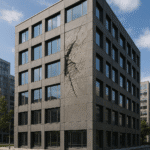In the realm of futuristic architecture, the development of smart building materials that react to weather changes is revolutionizing the way we design and interact with our built environment. These innovative materials are not only enhancing the aesthetic appeal of structures but also significantly improving their functionality and sustainability. As we delve deeper into this fascinating subject, we will explore the various types of smart materials, their applications, and the potential they hold for the future of architecture.
Understanding Smart Building Materials
Smart building materials are engineered to respond dynamically to environmental stimuli, such as temperature, humidity, light, and wind. These materials are designed to adapt to changing weather conditions, thereby optimizing the performance and energy efficiency of buildings. The concept of smart materials is rooted in the idea of creating structures that can self-regulate and maintain optimal conditions without the need for external intervention.
One of the most common types of smart materials used in architecture is thermochromic glass. This glass changes its tint in response to temperature fluctuations, allowing it to control the amount of heat and light entering a building. By doing so, it reduces the need for artificial heating and cooling, leading to significant energy savings. Another example is photochromic materials, which adjust their transparency based on the intensity of sunlight, providing natural shading and reducing glare.
Shape-memory alloys are another fascinating category of smart materials. These metals can return to a predetermined shape when exposed to specific temperatures. In architecture, they are used in dynamic facades and structural components that can adjust their form to optimize airflow and light penetration. This adaptability not only enhances the comfort of building occupants but also contributes to the overall energy efficiency of the structure.
Applications and Benefits of Weather-Responsive Materials
The integration of smart building materials into architectural design offers numerous benefits, ranging from improved energy efficiency to enhanced occupant comfort. One of the primary applications of these materials is in the development of responsive building envelopes. These envelopes can adjust their properties in real-time to maintain optimal indoor conditions, reducing the reliance on mechanical heating, ventilation, and air conditioning systems.
For instance, buildings equipped with smart windows can automatically adjust their tint to minimize heat gain during hot weather and maximize solar gain during colder months. This not only reduces energy consumption but also enhances the comfort of occupants by maintaining a consistent indoor temperature. Additionally, smart materials can contribute to the aesthetic appeal of buildings by allowing architects to create dynamic and visually striking facades that change appearance based on environmental conditions.
Another significant application of smart materials is in the development of self-healing structures. These materials can repair themselves when damaged, extending the lifespan of buildings and reducing maintenance costs. For example, self-healing concrete contains microcapsules filled with a healing agent that is released when cracks form, effectively sealing the damage and preventing further deterioration.
Moreover, smart materials can play a crucial role in enhancing the sustainability of urban environments. By reducing the energy consumption of buildings and minimizing the need for resource-intensive maintenance, these materials contribute to the overall reduction of carbon emissions. This aligns with the growing emphasis on sustainable development and the need to create resilient cities that can withstand the challenges posed by climate change.
The Future of Smart Building Materials
As technology continues to advance, the potential applications of smart building materials are expanding rapidly. Researchers are exploring new ways to enhance the responsiveness and functionality of these materials, paving the way for even more innovative architectural solutions. One area of focus is the development of materials that can harvest energy from environmental sources, such as solar panels integrated into building facades that generate electricity while providing shading.
Another promising avenue is the use of biomimicry in the design of smart materials. By drawing inspiration from nature, architects and engineers are creating materials that mimic the adaptive capabilities of living organisms. For example, materials that can change their surface texture to repel water or dirt, similar to the way lotus leaves remain clean, are being developed to create self-cleaning building surfaces.
Furthermore, the integration of smart materials with digital technologies, such as the Internet of Things (IoT), is opening up new possibilities for building automation and control. By connecting smart materials to a network of sensors and actuators, buildings can be designed to respond autonomously to environmental changes, optimizing their performance in real-time. This level of automation not only enhances the efficiency of buildings but also provides valuable data that can be used to inform future design decisions.
In conclusion, the development of smart building materials that react to weather changes represents a significant leap forward in the field of architecture. These materials offer a range of benefits, from improved energy efficiency and occupant comfort to enhanced sustainability and aesthetic appeal. As research and innovation continue to drive the evolution of smart materials, we can expect to see even more groundbreaking applications that will shape the future of our built environment.










